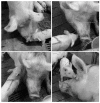Sow-Piglet Nose Contacts in Free-Farrowing Pens
- PMID: 31370345
- PMCID: PMC6720435
- DOI: 10.3390/ani9080513
Sow-Piglet Nose Contacts in Free-Farrowing Pens
Abstract
Nose contact is a frequent form of social behaviour in pigs, but the motivational reasons underlying this behaviour remain unclear. We investigated the frequency, direction and type of sow-piglet nosing behaviour and its association with sow and piglet traits. Social nosing behaviour was recorded by live observations and video recordings in 22 sows and their 249 piglets in free-farrowing pens once weekly during the first three weeks after farrowing (3 times 30 min of observations per litter). Piglet-to-sow nosing occurred on average 32.8 ± 2.35 times per 30 min per litter. Heavier piglets at one week of age nosed the sow more than lighter piglets (P = 0.01). Piglet-to-sow nosing was unrelated to the piglet's sex or teat order. Sow-to-piglet nosing occurred on average 3.6 ± 0.53 times per 30 min, and this was unrelated to litter size. Primiparous sows nosed their piglets more in the second week after farrowing. Litters in which piglet-to-sow nosing occurred more showed less variation in the expression of this behaviour across the weeks. Social nosing between sow and piglets deserves further research to understand the positive implications of this behaviour for sow and piglet welfare.
Keywords: behaviour; contact; free-farrowing; maternal care; mother–offspring; nosing; piglet; positive welfare; recognition; sow.
Conflict of interest statement
The authors declare no conflict of interest.
Figures





Similar articles
-
Sow communication with piglets while being active is a good predictor of maternal skills, piglet survival and litter quality in three different breeds of domestic pigs (Sus scrofa domesticus).PLoS One. 2018 Nov 14;13(11):e0206128. doi: 10.1371/journal.pone.0206128. eCollection 2018. PLoS One. 2018. PMID: 30427860 Free PMC article.
-
Higher light intensity and mat temperature attract piglets to creep areas in farrowing pens.Animal. 2019 Aug;13(8):1696-1703. doi: 10.1017/S1751731118003300. Epub 2019 Jan 3. Animal. 2019. PMID: 30604656
-
Reducing sow confinement during farrowing and in early lactation increases piglet mortality.J Anim Sci. 2016 Jul;94(7):3022-9. doi: 10.2527/jas.2015-0145. J Anim Sci. 2016. PMID: 27482689
-
Impact of Non-Confinement Accommodation on Farrowing Performance: A Systematic Review and Meta-Analysis of Farrowing Crates Versus Pens.Animals (Basel). 2019 Nov 12;9(11):957. doi: 10.3390/ani9110957. Animals (Basel). 2019. PMID: 31726676 Free PMC article. Review.
-
A Review of Success Factors for Piglet Fostering in Lactation.Animals (Basel). 2018 Mar 9;8(3):38. doi: 10.3390/ani8030038. Animals (Basel). 2018. PMID: 29522470 Free PMC article. Review.
Cited by
-
Improving young pig welfare on-farm: The Five Domains Model.J Anim Sci. 2022 Jun 1;100(6):skac164. doi: 10.1093/jas/skac164. J Anim Sci. 2022. PMID: 35536191 Free PMC article. Review.
-
Welfare of pigs on farm.EFSA J. 2022 Aug 25;20(8):e07421. doi: 10.2903/j.efsa.2022.7421. eCollection 2022 Aug. EFSA J. 2022. PMID: 36034323 Free PMC article.
-
Impact of proximity definitions and sampling rates on social networks in pigs based on tracking using computer vision.Sci Rep. 2025 Mar 21;15(1):9759. doi: 10.1038/s41598-025-93830-8. Sci Rep. 2025. PMID: 40119050 Free PMC article.
References
-
- Edwards S.A., Broom D.M. Behavioural interactions of dairy cows with their newborn calves and the effects of parity. Anim. Behav. 1982;30:525–535. doi: 10.1016/S0003-3472(82)80065-1. - DOI
LinkOut - more resources
Full Text Sources

